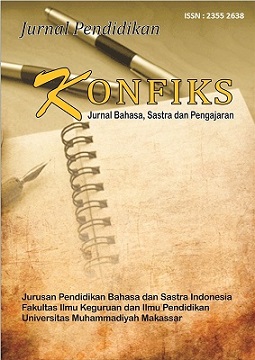SUBJECT TEST IN BANUA LANGUAGE CLAUSE CONSTRUCTIONS: A TYPOLOGICAL APPROACH
DOI: https://doi.org/10.26618/konfiks.v12i2.18410
clause, subject, banua language, typology
Abstract
Banua Language is one of the languages originating from the province of East Kalimantan. Banua Language is part of the Austronesian language family. This research on Banua Language uses a syntactic typology approach. The aim of this study is to explain the behavior of subjects in clause construction within Banua Language. As a regional language in East Kalimantan, Banua Language has a unique syntactic structure. Not much research has been done on the function and position of subjects in this language. Therefore, this study examines subjecthood through canonical position, relativization, and control, the three main tools according to Keenan and Comrie (1983). The distributional method was used to analyze data collected from native speakers through elicitation and uninvolved observation techniques. The study shows that in Banua Language, the subject always precedes the verb in both intransitive and transitive clauses. Additionally, the subject can be relativized exclusively using the form "anu". Furthermore, the subject can be controlled in serial verb constructions, but arguments without subjects do not exhibit the same characteristics. The findings indicate that Banua Language has subjecthood properties that align with universal syntactic principles and contribute to the typological mapping of Indonesian languages. The theoretical implication of this research is expected to strengthen the theory of subjecthood from a syntactic typology perspective and provide a global linguistic database. In addition, the practical implication expected from this research is to serve as a means for preserving the regional language and a foundation for developing the Banua Language grammar.
References
Aritonang, B. (2018). Properti Subjek Bahasa Tetum Dialek Foho di Desa Nanaet Dubessi, Kabupaten Belu, Provinsi NTT. Gramatika: Jurnal Ilmiah Kebahasaan Dan Kesastraan, 6(2), 100–110.
Arka, I. W. (2017). The Core-Oblique Distinction in Some Austronesian Languages of Indonesia and Beyond. Linguistik Indonesia, 35(2), 101–144.
Arka, I. W. (2019). Grammatical relations in Balinese. In Argument Selectors (pp. 257–299). John Benjamins Publishing Company.
Artawa, K. (2013). The Basic Verb Construction In Balinese. Voice Variation in Austronesian Languages of Indonesia, 54, 5–27.
Basaria, I. (2013). Tipologi Gramatikal dan Sistem Pivot Bahasa Pakpak-Dairi. LITERA, 12(1).
Basaria, I. (2018). Relasi Gramatikal Subjek Bahasa Pakpak Dairi: Kajian Tipologi. Talenta Conference Series: Local Wisdom, Social, and Arts (LWSA), 1(1), 49–58.
Brahmana, R. A. (2022). Aliansi Gramatikal Pada Bahasa Mandarin: Tipologi Bahasa. LINGUA: Jurnal Bahasa, Sastra, Dan Pengajarannya, 19(2), 113–121.
Budiarta, I. W. (2016). Perilaku Subjek dalam Bahasa Kemak Kabupaten Belu Nusa Tenggara Timur. LITERA, 15(1).
Comrie, B., & Keenan, E. L. (1983). Noun Phrase Accessibility Revisited. Language, 55(3), 649. https://doi.org/10.2307/413321
Dixon, R. M. W. (2010). Basic Linguistic Theory Volume 2: Grammatical Topics (Vol. 2). OUP Oxford.
Fathonah, S., & Romadhan, A. D. (2021). Active and Passive Voice In Bulungan Language. Rainbow: Journal of Literature, Linguistics and Culture Studies, 10(2), 96–105.
Givón, T. (1994). Voice and Inversion (Vol. 28). John Benjamins Publishing Company.
Harahap, A. L. (2019). Kesubjekan Dalam Bahasa Batak Angkola: Ancangan Tipologi. Red: Revolution of English Department Journal, 3(2).
Kisseberth, C. W., & Abasheikh, M. I. (1977). The Object Relationship in Chi-Mwi: ni, a Bantu Language. In Grammatical relations (pp. 179–218). Brill.
Kridalaksana, H. (2014). Kamus Linguistik. In Wacana, Journal of the Humanities of Indonesia (Vol. 11).
Palmer. (2016). Grammatical Roles and Relations. Cambridge: Cambridge University Press.
Prismayanti, R., & Mulyadi, M. (2022). Subjek Bahasa Korea dan Bahasa Indonesia. Caraka: Jurnal Ilmu Kebahasaan, Kesastraan, Dan Pembelajarannya, 8(2), 184–195.
Romadhan, A. D. (2021). Kesubjekan Bahasa Dayak Kenyah Lepo’Tau. International Seminar on Austronesian Languages and Literature, 9(1), 17–21.
Romadhan, A. D. (2022). Subjek dan Oblik Bahasa Tidung. Cakrawala Linguista, 5(2), 70–78.
Romadhan, A. D., Hakim, L., Selia, A. K. W., Ekasani, K. A., Wuarlela, M., Hiariej, C., … Susanti, R. (2023). Pengantar Linguistik Umum. CV. Intelektual Manifes Media.
Romadhan, A. D., & Sari, R. K. (2021). Subjecthood In Punan Tebunyau Language: Kesubjekan Bahasa Punan Tebunyau. Jurnal Kata: Penelitian Tentang Ilmu Bahasa Dan Sastra, 5(2), 224–234.
Said, R., Artawa, K., & Satyawati, M. S. (2016). Peran Semantis Subjek Dalam Klausa Bahasa Muna. Mozaik Humaniora, 16(2).
Selia, A. K. W., & Romadhan, A. D. (2023). Subjecthood in Banjarnese. Indonesian Journal of EFL and Linguistics, 263–277.
Selia, A. K. W., & Romadhan, A. D. (2024). Verb-verb construction in Bugis language: A linguistic typology approach. Jurnal Arbitrer, 11(4), 535–546.
Sugono, D., Moeliono, A. M., Purwo, B. K., & Steinhauer, H. (1991). Pelesapan subjek dalam bahasa Indonesia.
Verhaar. (2017). Pengantar Linguistik Umum. Yogyakarta: Gadjah Mada University Press.
Wechsler, S., & Arka, I. W. (1998). Syntactic ergativity in Balinese: An argument structure based theory. Natural Language & Linguistic Theory, 16(2), 387–442.
Downloads
Published
Issue
Section
License
Authors who publish with this journal agree to the following terms:
The author owns the copyright and grants the journal rights for first publication with the work simultaneously licensed under a Creative Commons Attribution License which allows others to share the work with acknowledgment of the work's authorship and initial publication in this journal.
Authors may enter into separate additional contractual agreements for the non-exclusive distribution of the published journal version of the work (for example, posting it to an institutional repository or publishing it in a book), with acknowledgment of its initial publication in this journal.
Authors are permitted and encouraged to post their work online (for example, in institutional repositories or on their websites) before and during the submission process, as this can lead to productive exchanges, as well as earlier and larger citations of published work (See The Effect of Open Access).
Statement of Authenticity and Manuscript Copyright can be downloaded: Here
After filling in the statement letter, please send via e-mail: konfiks@unismuh.ac.id





.png)


